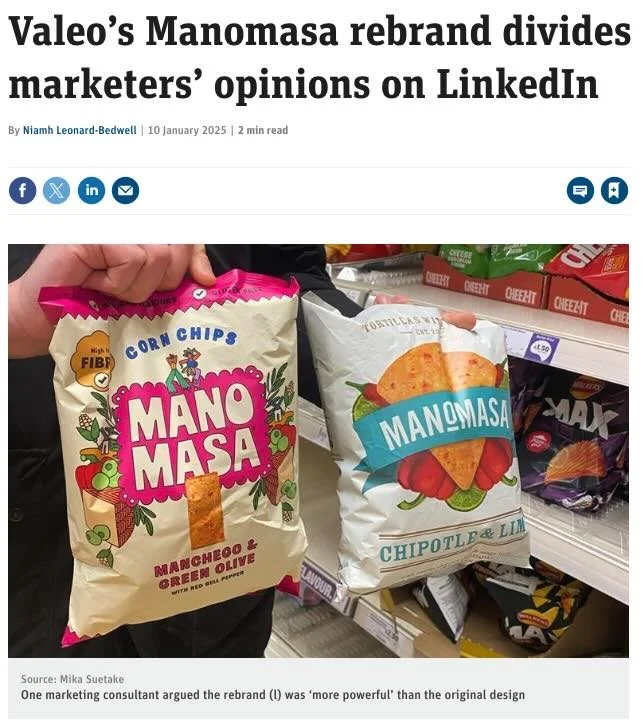SBR 50: Packaging REDESIGN STRATEGY: Insights from the shelf
What’s your packaging redesign strategy? Sure, it often seem exciting to make a few changes — it’s a chance to refresh and reinvigorate your brand. But as tempting as it may be, the risks of a radical change often outweigh the potential benefits. For every successful revamp, there are stories like Tropicana’s infamous rebrand, which saw sales plummet as loyal customers failed to recogniSe the product on shelves. So, when is a redesign worth the gamble?
Having been featured in Niamh Leonard-Bedwell’s article in The Grocer about the recent Manomasa packaging redesign, I reflected on the circumstances that warrant such a change, the critical pitfalls to avoid and what you should consider in your packaging redesign strategy.
The Risks of a Packaging Redesign
1. Years of Brand Recognition Can Be Lost: Building a recognisable brand takes time and consistency. Packaging serves as a visual shorthand for your product—it’s how customers find you in a crowded marketplace. A drastic redesign risks breaking this connection. If consumers can’t recognise your product on the shelf, they’re unlikely to buy you.
Even when the execution is flawless, the potential sales uplift from a redesign can be modest. According to Nielsen BASES, “Optimized pack redesigns generate an average of 5.5% lift in forecasted revenue,” but 9 out of 10 redesigns fail to deliver a meaningful impact. The costs—financial and reputational—must be weighed carefully.
2. The Financial Costs Can Be Significant: Packaging redesigns come with a long list of expenses: discarding existing inventory, creating new printing plates, redesigning collateral, and more. Even a modest redesign can result in substantial costs. If the projected uplift in sales isn’t enough to offset these expenses, the business could face financial setbacks.
When a Redesign Makes Sense
Despite the risks, there are times when a packaging redesign is necessary or even critical. The key is ensuring that the redesign aligns with broader strategic goals and addresses specific challenges.
1. Responding to a Crisis: If your brand is rapidly losing market share, a redesign may be a necessary part of a broader repositioning effort. For example, I was involved in a dramatic redesign of the Bulmers cider brand during a period of steep decline. The redesign wasn’t just about aesthetics; it was one component of a strategic repositioning that successfully turned the brand around. In cases like this, “desperate times call for desperate measures.” A redesign must be backed by solid reasoning and integrated into a larger strategy to revive the brand.
2. Aligning with a Brand Evolution: As brands evolve, their packaging must keep pace. If your business has adopted new values—such as sustainability—or entered new markets, the existing packaging may no longer reflect the brand’s identity or appeal to target consumers. But I’d be advocating an iterative approach rather than a radical redesign in one leap.
3. Correcting Functional or Market Challenges: Sometimes, redesigns address practical issues: packaging that’s hard to open, unclear labeling, or designs that fail to stand out on shelves. When done strategically, these changes can improve usability, compliance, and consumer appeal without straying too far from your core brand identity.
getting the Right packaging design strategy
For me, the recognisability of “something ugly” is better than unrecognisable beauty. While there are exceptions, brands must tread carefully with redesigns. It’s not just about looking fresh or contemporary. It’s not about whether you or I prefer a particular design—it’s about maintaining the hard-earned trust and recognition that make your brand familiar and loved by consumers.
So, before jumping into a redesign, ask yourself:
• Are the changes solving a significant problem?
• Will the redesign strengthen the brand’s connection with its target audience?
• Is the potential uplift worth the investment?
The answers to these questions will determine whether your redesign is a strategic step forward or a costly misstep. And if you need some agnostic advice, then you know where we are.

